Expert Advice
Get Down [to the Fish] with Tom Johannesen
Many Stillwater anglers feel that a type 3 sinking line is all one needs to cover all the depths when using a wet fly in interior lakes. Unfortunately this could not be any further from the truth. When purchasing a rod and reel combo from a fly shop the majority of the time they come with a full floating line and a type 3 sinking line. The reason they use a type 3 when assembling the combo packages is because the lines are suitable for the average angler when trolling a fly behind the boat but it doesn’t mean it’s the right fly line. Without the knowledge of sink rates and what sinking lines can do for the angler you are missing out on a high percentage of catchable fish. Learning how sink rates work and properly utilizing them with allow you to catch more fish year round under any weather conditions.
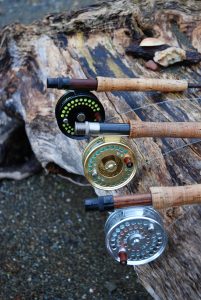 How Sink Rates Work
How Sink Rates Work
Sinking lines come in a wide variety of sink rates from as slow sinking to as fast as type 7 lines which head to the bottom at an incredible seven inches per second. The key to being a more productive angler is knowing exactly where your line is in the water column at any given time. This plays an important role as it will allow you to cover the some depths cast after cast if fish are located at a certain depth.
Sinking lines are designed to get the fly to the fish when they are holding in depths from a few feet deep to depths in excess of forty feet. These lines are always dark in color unlike floating lines that are bright in color so the angler can spot them on the surface when fishing a hatch. As a general rule of thumb the darker the line the faster the sink rate. In other words a light brown line is generally a slow sinking line and a dark brown or black line would be an extremely fast sinking line. The only exception to this rule is intermediate sinking lines which are clear or slightly tinted to be camouflaged in the water.
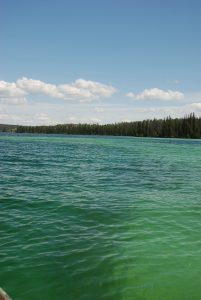 The unique characteristics of sinking lines are the sink rates themselves. The newer generation of lines have made our job as anglers a little easier as we can now cover water that was next to impossible to cover in the past. Knowing the right fly line to use at any given time is something that takes a little time and experience to figure out. To make sink rates easy to understand, the type number is the sink rate, a type 3 sinks at approximately three inches per second and a type 6 at approximately six inches per second and so on. An intermediate line sinks at a leisurely inch and a half to two inches per second which allows it to be used in very specific applications.
The unique characteristics of sinking lines are the sink rates themselves. The newer generation of lines have made our job as anglers a little easier as we can now cover water that was next to impossible to cover in the past. Knowing the right fly line to use at any given time is something that takes a little time and experience to figure out. To make sink rates easy to understand, the type number is the sink rate, a type 3 sinks at approximately three inches per second and a type 6 at approximately six inches per second and so on. An intermediate line sinks at a leisurely inch and a half to two inches per second which allows it to be used in very specific applications.
When selecting sinking lines for most lake fishing there are three lines that should be part of every anglers arsenal to maximize ones time on the water. The three must have wet lines are an intermediate line, a type 3 line and a type 6 line.
Starting with the intermediate line, it is best utilized when fishing over shoals were the water is from two to six feet deep. The line works well is shallow water is it doesn’t spook the fish due to its clarity and it works perfect for imitations that are generally fished slow. I find an intermediate line is very productive when using shrimp, damsel nymphs, blood worms and water boatman patterns. It only makes good sense that slow sinking lines work well over shoals as they keep the fly in the zone for the entire cast where a fast sinking line would get snagged up on the bottom long before the fly made it back to the boat. The reason why these lines work well for boatman is because they to swim slow and tend to live near the surface where the line can be utilized. As a general rule I use a clear line in crystal clear lakes and I prefer camouflaged clear lines in lakes that are slightly tinted or tea colored.
The type three medium speed sinking lines are best fished in depths from six to fifteen feet deep when using dragon nymphs, leeches and attractor patterns to mention a few. I have also found a type three is the right fly line when fishing chironomids in the summer months when the flies need to be fished down deeper out of the suns glare. When trying this technique, simply lay out a cast let it sink for a determined amount of time based on the depth you are anchored in and slowly retrieve the line back to the boat. The key is to retrieve the line extremely slow as chironomids don’t swim they merely wiggle their way to the surface to emerge.
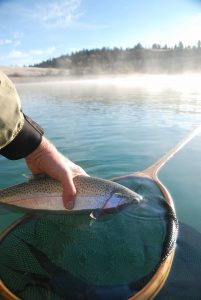 The third and my personal favorite go to line when fishing interior lakes is a type 6 fast sinking wet line. The truth is I fish a type 6 wet line over seventy-five percent of the time I’m on the water. When utilized properly type six lines are worth their weight in gold. A type six line can be used in many different ways from covering shallow shoals to fishing depths to over forty feet. Over the past few years Booby flies have become very popular with interior Stillwater anglers. Booby flies are brightly colored attractor patterns that have large foam eyes to make these patterns buoyant. These attractors are fished behind a fast sinking wet line as the fly will remain on the surface while the wet line sinks. Once the line is on or near the bottom then the fly will head for the bottom once retrieving begins.
The third and my personal favorite go to line when fishing interior lakes is a type 6 fast sinking wet line. The truth is I fish a type 6 wet line over seventy-five percent of the time I’m on the water. When utilized properly type six lines are worth their weight in gold. A type six line can be used in many different ways from covering shallow shoals to fishing depths to over forty feet. Over the past few years Booby flies have become very popular with interior Stillwater anglers. Booby flies are brightly colored attractor patterns that have large foam eyes to make these patterns buoyant. These attractors are fished behind a fast sinking wet line as the fly will remain on the surface while the wet line sinks. Once the line is on or near the bottom then the fly will head for the bottom once retrieving begins.
I find that type six and seven lines are best fished in depths from ten to twenty feet deep when working the transitions of shoals. There is simply no better line for scouting a lake with larger patterns and should be a must have tool for every avid angler.
Sink rate identification chart is as follows:
| TYPE | CHARACTER | SINK RATE (inch/second) | Effective Depth |
| 1 | slow (intermediate) | 1 1/2 – 2 ips | 2′ – 6′ |
| 3 | extra fast | 3 1/2 – 4 ips | 3′ – 7′ |
| 4 | super sinker | 4 1/2 – 5 ips | 4′ – 10′ |
| 5 | super fast | 5 1/4 – 6 ips | 8′ – 15′ |
| 6 | extra super sinker | 6 1/4 – 7 ips | 10′ – 20′ |
| 7 | deep 7 | 7 1/4 – 8 ips | 10′ – 30′ |
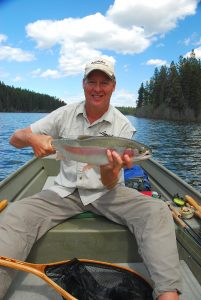 Now I know I said that we must all have a variety of sinking lines to be an efficient angler but there is one more piece of the puzzle to mention. I will touch on these lines lightly as sink-tip lines are primarily designed for use in moving water as the main body (floating portion) of the line can be mended while the tip (sinking portion) gets the fly down to the fish. The sinking part of the line comes in a variety of sink rates based on the same principal as the full sinking lines. As a rule of thumb the darker the tip the faster it sinks. On top of that the sink-tip portion can vary in lengths from as short as five feet to as long as thirty.
Now I know I said that we must all have a variety of sinking lines to be an efficient angler but there is one more piece of the puzzle to mention. I will touch on these lines lightly as sink-tip lines are primarily designed for use in moving water as the main body (floating portion) of the line can be mended while the tip (sinking portion) gets the fly down to the fish. The sinking part of the line comes in a variety of sink rates based on the same principal as the full sinking lines. As a rule of thumb the darker the tip the faster it sinks. On top of that the sink-tip portion can vary in lengths from as short as five feet to as long as thirty.
The sink-tip lines with longer tips can also be used in lakes for trolling or fishing along the edges of shoals. Sink-tip lines always consist of two colors. The floating portion is bright in color and the sinking portion dark as with the regular sinking lines. The sink-tip lines also come with a clear tip variety ideal for fishing over shoals or when imitating insects that swim close to the surface.
I hope this information helps you better understand the mysteries of sinking lines and that you’ll experiment next time you’re on the water so that you find the right fly line for your situation.
–Tom Johannesen
P.S. For more information on selecting the right line for your setup check out Rio’s comprehensive line matching tool found here.
An avid angler, seminar host, and writer, Tom Johanesen has had over 200 works published in a plethora of Outdoor Magazines. From his home base in Coquitlam, British Columbia Canada, he explores his home waters and beyond.


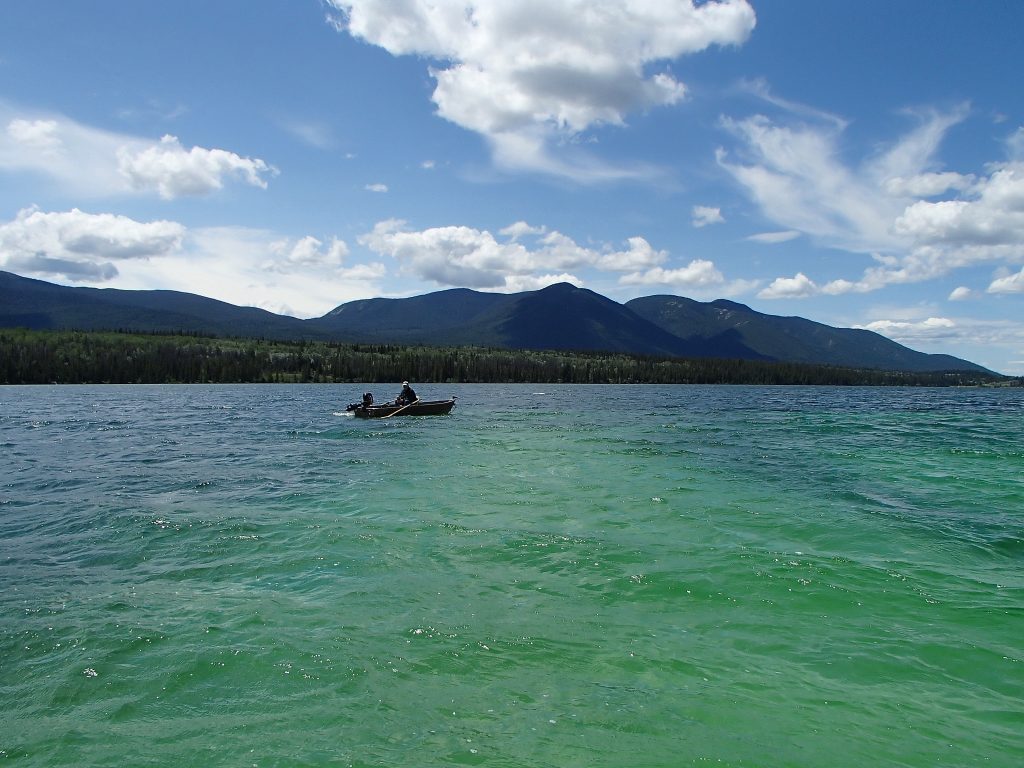
Wonderful article by Tom Johanesen. Thank you
Great article Tom. I know a lot of my buddies are good Chronie fisherman and when things slow down, they switch to an intermediate sink and struggle. I had a day in the late 70’s where the caddis hatch didn’t materialize, and just on a stroke of luck, I switched to an extra fast sink, probably like a type 3 now, and landed 7 fish between 3 and 6 lbs. I have had a full arsenal of wet lines ever since, and am usually the 1st one to switch, when the Chronies aren’t going off.
Can I get advice Ive inherited a number of fly lines but dont know which does what,ie sink, float etc
Hi Willie,
It can be very difficult to tell if the lines are just loose other than floating lines which are one solid bright colour. You can identify the weight of a line by weighing the first 30 feet on a scale in grains, but density is tough.
Lot of info in there and nice pics!
Thanks Glenn,, It was an article that needed to be written to help clarify sinking lines. Try the countdown method next time your on the water.